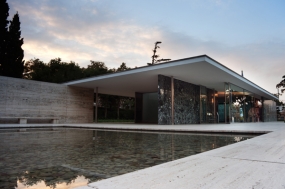The Roots of the Barcelona Pavilion
For years scholars and historians have attributed the origins of Ludwig Mies van der Rohe’s landmark design for the Barcelona Pavilion to the revolutionary spatial experiments he undertook beginning in the early 1920s. But the roots of Mies’s ideas almost certainly extend further back, to his early years in Berlin before World War I. This lecture will examine other possible sources for Mies’s complex and remarkable work.
Christopher Long is professor of architectural and design history at the University of Texas at Austin. He studied at the universities of Graz, Vienna, and Munich and received his doctorate at the University of Texas in 1993. In 1994–1995, he taught at the Central European University in Prague. He is the author of Josef Frank: Life and Work (2002), Paul T. Frankl and Modern American Design (2007), The Looshaus (2012), Josef Frank: Schriften / Writings (2012, edited with Tano Bojankin and Iris Meder), Kem Weber: Designer and Architect (2014), and Der Fall Loos (2015).
Christopher Long lectured at the Villa Tugendhat in November 2012 and was also the very first foreign lecturer, who was introduced in the Villa Tugendhat. His lecture on the architectural space concept by Ludwig Mies van der Rohe, Adolf Loos, Oskar Strnad, Josef Frank and Hans Scharoun gained great success and acclaim.
The lecture will be held on Monday, 23 March 2015 at 5 pm. (A tour of the villa is not included in the lecture).
The lecture will be in English and will not be interpreted.
Admission: 100,- CZK; students and seniors 50,- CZK
A reservation is required for the lecture, telephone: +420 515 511 015/017
or e-mail: info@tugendhat.eu (limited capacity, 70 people).
A poster for the lecture can be downloaded here.



